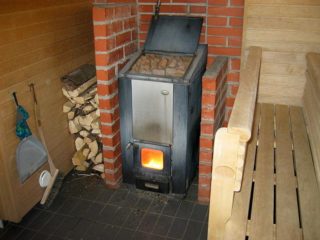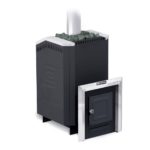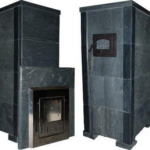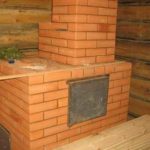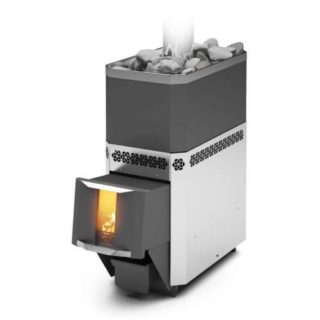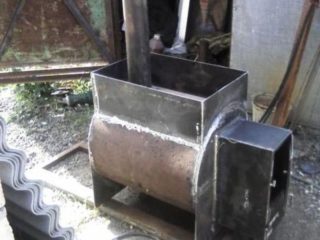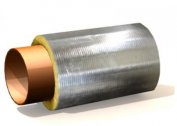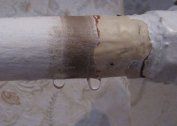The traditional Russian stove for a bathhouse, melted with ordinary wood, has several designs and various capacities. It can be made of brick or welded from thick steel / cast iron billets. In addition to the type of material used, when choosing a furnace design, attention is paid to its thermal return (power).
Basic requirements for choosing a furnace for a bath
Before choosing the right sample of the furnace device, you will need to familiarize yourself with the basic conditions for its effective operation. The following requirements are set for a wood-burning stove:
- should warm the air in the steam room to 40-50 degrees in the lower zone with a gradual increase in heat to 80 degrees under the ceiling;
- requires quick heating of stones to a high temperature and maintaining it at the same level;
- the design should exclude the possibility of penetration of smoke and carbon monoxide into the steam room itself.
Additional requirements for choosing a wood sauna stove are at the discretion of the owner. Someone may need a metal stove for a bath to heat the room and allow to store large volumes of hot water.
Determining the power of the furnace
 By power is meant the thermal return in kilowatts, reduced to the electrical equivalent. When choosing this indicator, attention is drawn first. Based on it, all other parameters are calculated:
By power is meant the thermal return in kilowatts, reduced to the electrical equivalent. When choosing this indicator, attention is drawn first. Based on it, all other parameters are calculated:
- dimensions and layout of the steam room;
- volumes of heated water in the tank;
- chimney system characteristics.
Based on this, the total number of people who can take bath procedures at the same time is also determined.
The power indicator should have an optimal value for each case. At the stage of selection by users, a characteristic mistake is made when a heater is purchased with excess power reserve. It is assumed that this will reduce the heating time of the steam room, but a further increase in power is no longer possible. Having reached the limit, wood-burning stoves switch to a stable mode of operation. As a result, the air becomes hot, and the stones remain unheated. It makes no sense to splash water on them - there will be no steam at all, or very little.
Materials used
The stove or stove in the bath is made of the following materials:
- simple cast iron;
- steel billets;
- brick (hearth or red).
- Steel
- Cast iron
- Brick
The life of the selected design depends on the quality of the source material. The most durable are modern stoves made on the basis of chrome steel. Steel units guarantee a good heat, eliminating the burning of oxygen in a steam room. The best product samples are produced by the Finnish companies Helo and Harvia.
Bath equipment with a cast iron stove is not easy to find, although the quality of the source material is considered good. Among the factory models, Sudarushka M from the domestic manufacturer Inzhkomtsentr deserves attention.
Brick stoves are perceived as a tribute to tradition and are built subject to reliable masonry. Brick heaters have their drawbacks, including many nuances:
- the complexity of the construction due to the lack of professional stove-makers;
- long heating (furnace period);
- the need to equip a “powerful” foundation.
All this leads to an increase in the cost of making a brick stove for a bathhouse.
Modernization direction
It is more convenient to trace the improvement of modern furnaces on the models "New Russia 18 L", manufactured by Teplodar companies. Her kit includes a chimney from pipes of the well-known company "Ferrum". The same process is monitored when reviewing the characteristics of the well-known Kalina unit.
Furnaces "Rus"
Highly efficient devices are used to produce highly dispersed steam, similar to a Russian steam room. Ideal for both private baths and public saunas. The market offers a wide range of models from this manufacturer. It has the usual basket ovens, as well as samples with a heater and a steam dispenser, having high efficiency.
Additional devices allow you to equip paired equipment with different configurations, determined by the preferences of the owner. The materials of the Rus products are selected taking into account the significant heat load on the furnace structure.
The Kalina furnace
The stove in the bath has a transparent screen that visually increases the size of the fuel channel. It provides a wide firebox, allowing you to observe the flame from different angles. The labyrinth gas duct of a special design provides fast heating of the steam room up to 30 cubic meters and high-quality heating of stones weighing up to 100 kilograms.
Thanks to the built-in heat exchanger, the water is heated in a metal remote tank (it is located in an adjacent room). Heat-resistant stainless steel of the furnace walls is chemically inert and not susceptible to oxidation, retaining oxygen in the air.
Do it yourself
To make an iron stove in the bathhouse with your own hands, you will need to prepare sheet steel of the greatest possible thickness. With limited costs, it is enough to choose steel sheets with a standard size of the order of 1.5-2.0 mm. After that you need to do the following:
- Prepare a sketch of the furnace, where all the details and their characteristic dimensions are indicated.
- Count the number of structural elements and their total area.
- Decide on the need for iron.
- Transfer dimensions from the drawing to metal, and then cut all the workpieces.
When cutting with a grinder, it is necessary to strictly maintain angles of 90 degrees, and also make sure that the opposite sides are the same in size. After that, a flat platform is selected on which the furnace body is assembled from the blanks. This will require:
- Place two workpieces at an angle on the ribs and make several tacks for welding.
- First, you need to adjust the current strength on the welding unit so that the arc does not melt the metal - then the seam will turn out to be uniform and durable.
- You need to grab 2-3 millimeters; 4-5 tacks are enough for one corner.
- It is important to control the position of the corner blanks, because the finished seam after cooling will lead the sheets to the sides.
- Aligning their position, check the angle of 90 degrees.
- In the same way, a second pair of blanks for sidewalls is picked up for spot welding.
- Two coal halves of the body are mounted and welded withstanding 90 degree joints.
The result is a steel box heater, which remains to weld the bottom and lid.
Closed above and below the skeleton of the future furnace has undigested slots, which are subsequently welded with a continuous seam.
Welding rules
When welding, the following points should be kept:
- It is impossible to precisely maintain the dimensions when grasping and fitting. This is not scary, because when welding with a continuous seam, they will hide and will not be noticeable - the run-up or deviations from different sides are compensated.
- So that when brewing the lid does not fall into the box, a high round stand is placed inside it.
- A sheet with a thickness of 10 mm is taken as the bottom of the internal heater. This will allow him to withstand the main heat of the flame, and too thin a bottom quickly burns out. After that, the smoke begins to flow into the steam room.
Having completed the design of the top and bottom, go to the preparation of holes.First, a small hole is made in the heater in the lower part - for the furnace.
- The box is laid horizontally and marking is applied in the right place.
- A grinder or a welding machine cuts a hole under the firebox.
- A door of the same size is cut from a sheet of metal billet.
- In the lower part (third) of the box in which the stones are placed, several holes are made for the pipes - their number is selected as necessary. They are placed at a distance of at least 5 cm from the lower partition to improve traction. They are supposed to install a box with heavy stones.
- In the upper part, another hole is boiled - to insert the inner case.
- On the perimeter of the hole on 3 sides, two plates with a width of 4 cm are attached to the weld - to strengthen the cut line. The first 3 strips are attached to the inner surface of the housing, and the remaining ones to the outer part of the window with mixing.
- Between the plates there is a gap sufficient to insert the inner box.
- One plate is welded to the inside and to the doors of the furnace - for reinforcement.
- The furnace from the ash pan is fenced off with a grid of steel bars with a diameter of 10-12 cm.
- For the complete combustion of firewood, a better flow of air is needed, so the grates are welded along the direction of the blower.
According to the assembly scheme, the furnace is made of 2 parts - internal and external - with a difference in size of about 10 centimeters. This clearance is necessary to remove combustion waste into the chimney. During assembly, the inner part is placed in the outer shell, which in the simplest case is mounted on smoke exhaust pipes. Their diameter is chosen arbitrarily, but not too small. The size should be enough to create good traction.
In the manufacture of a home-made sauna stove with your own hands, the main thing is to monitor all joints in the design that exclude heat loss and the exit of combustion products to the room.
